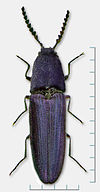Dixton Wood
| Site of Special Scientific Interest | |
 Example - Violet Click Beetle (Limoniscus violaceus) | |
 Location within Gloucestershire | |
| Location | Gloucestershire |
|---|---|
| Grid reference | SO979313 |
| Coordinates | 51°58′50″N 2°01′53″W / 51.980608°N 2.031257°WCoordinates: 51°58′50″N 2°01′53″W / 51.980608°N 2.031257°W |
| Interest | Biological |
| Area | 13.14 hectare |
| Notification | 2000 |
| Natural England website | |
Dixton Wood (grid reference SO979313) is a 13.14-hectare (32.5-acre) biological Site of Special Scientific Interest in Gloucestershire, notified in 2000.[1][2] Dixton Wood is recognised as a Special Area of Conservation (SAC) under the EU Habitats Directive.[3][4]
Location[]
The wood lies in the Cotswold Area of Outstanding Natural Beauty near Winchcombe and north of Cheltenham. It is a steep east facing woodland, which is surrounded by permanent grassland. It is in the foothills of the scarp and may be considered as a similar landscape feature as that of the nearby Bredon Hill which is a national nature reserve (NNR).[1]
Protected Species interest[]
The site is notified for its population of Violet Click Beetle (Limoniscus violaceus), and for a deadwood (saproxylic) beetle assemblage. The Violet Click Beetle is protected under Schedule 5 of the Wildlife and Countryside Act, 1981 (as amended) and listed on Annex IIa of the EC Directive 92/43/EEC on the conservation of natural habitats and of wild fauna and flora. Its presence indicates the great importance of the wood, and indicates habitat of a high quality for this special invertebrate group (deadwood beetle fauna).[1]
The beetle is currently only known elsewhere in Britain on Bredon Hill NNR and in Windsor Forest. There are also some fifteen sites in central Europe.[1]
Woodland structure[]
There is a well-developed high forest structure and the management of the wood has yielded a number of large, low ash pollards and a range of deadwood. The moist clay soils, the eastern aspect and the ground and scrub maintain a humid microclimate. This is likely to enhance the decay process, which has resulted in a continuity of forest conditions.[1]
Reports in by Natural England in November 2010 are detailed in the ageing of the trees, and planting needs to maintain the favourability of the site.[5]
References[]
- ^ a b c d e Natural England SSSI information on the citation
- ^ Tewkesbury Borough Local Plan to 2011, adopted March 2006, Appendix 3 'Nature Conservation', Sites of Special Scientific Interest
- ^ Information on Dixton Wood Special Area of Conservation designation
- ^ Joint Nature Conservation Committee Listing of Special Areas of Conservation
- ^ Natural England SSSI information on the Dixton Wood unit
SSSI Source[]
- Natural England SSSI information on the citation
- Natural England SSSI information on the Dixton Wood unit
External links[]
- Natural England (SSSI information)
- Sites of Special Scientific Interest in Gloucestershire
- Sites of Special Scientific Interest notified in 2000
- Forests and woodlands of Gloucestershire
- Cotswolds
